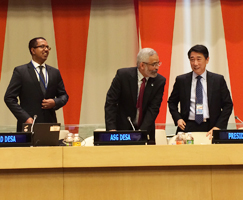Kicking off today with the forecast for Europe being presented in Geneva, regional launches will also take place in New Delhi, and during the coming days in Mexico, Moscow and Pretoria. Addis Ababa, Bangkok and Beirut are also planning to hold briefings in the last week of January.
The complete report was also presented at the ECOSOC Bureau general briefing of Member States at 缅北禁地Headquarters by 缅北禁地DESA’s Assistant Secretary-General for Economic Development, Lenni Montiel and by Hamid Rashid, Chief of the Economic Monitoring Unit of 缅北禁地DESA’s Development Policy and Analysis Division.
“The WESP 2016 underscores that global growth faltered last year and only a very modest improvement is expected in 2016 and 2017,” said Mr. Montiel. “Clearly, the projected growth of the global economy will impact efforts to pursue sustainable development in all three areas - economic, social and environmental.”
 Mr. Montiel discussed last year’s milestone events as well as the challenges and opportunities that the international community now face given the headwinds of the global economy.
Mr. Montiel discussed last year’s milestone events as well as the challenges and opportunities that the international community now face given the headwinds of the global economy.“The historic agreements achieved last year face formidable challenge as we move from commitments to implementation,” Mr. Montiel said. “But these challenges are not insurmountable, especially if we confront them with a collective resolve," he underlined.
“We need stronger and more coordinated policy efforts to put the world economy on a trajectory of robust, inclusive and sustainable economic growth, which will be critical for achieving the 2030 Sustainable Development Agenda and for realizing our vision of a world in which no one is left behind.”
European Union fuels world trade
Looking at the forecast for Europe, the WESP reveals that the European Union is now the driving force behind world trade growth, supported by the high level of intra-regional trade and also by competitiveness gains relative to the United States.
Gross Domestic Product (GDP) growth in the EU-15 is expected to accelerate from 1.8 per cent in 2015 to 2.0 per cent in 2016 and 2.1 per cent in 2017. However, the economic performance of Austria, Finland, France and Italy has lagged behind other EU-15 members and existing fragilities have been accentuated by exposure to the Russian Federation.
South-Eastern Europe improves economic activity with low oil prices
 Economic activity in South-Eastern Europe also picked up in 2015 and is expected to accelerate further to 2.6 per cent in 2016 and 3.0 per cent in 2017. The region has benefited from low energy prices and accelerating growth in the EU.
Economic activity in South-Eastern Europe also picked up in 2015 and is expected to accelerate further to 2.6 per cent in 2016 and 3.0 per cent in 2017. The region has benefited from low energy prices and accelerating growth in the EU.The economic recovery supported job creation, although unemployment levels remain very high. Youth employment is a particularly acute problem. High unemployment is accompanied by low activity rates, which limits growth potential.
Recession in Russia has significant regional spillovers
The recession in the Russian Federation had a depressing influence throughout the region. Remittances from the Russian Federation fell by nearly 50 per cent in dollar terms, while reduced export and investment demand also adversely affected the economies of the CIS and Georgia.
Output declines were also observed in other large economies, including Belarus and Ukraine. The aggregate GDP of the CIS and Georgia is estimated to have contracted by about 3.0 per cent in 2015.
A return to growth is expected in 2016, but the recovery will be limited, with GDP increasing by about 0.7 per cent in 2016 and 1.8 per cent in 2017. According to the report, the Russian economy will stagnate in 2016, before returning to a modest growth of 1.2 per cent in 2017.

